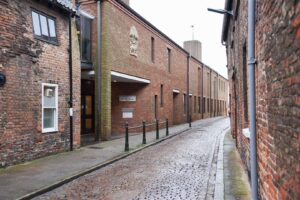Two of Lynn’s most historic buildings are set to receive a share of £15million from the Department for Culture, Media and Sport.
St George’s Guildhall on King Street and Greenland Fishery on Bridge Street will be getting grants thanks to the scheme led by Historic England.
The funding has been issued in a bid to “rescue” listed buildings and sites facing dereliction or demolition.
A total of six historic places in the East of England will be given the life-changing grants.
The one-year fund prioritises heritage sites serving disadvantaged communities and which demonstrate strong local benefits, from job creation to cultural events.
This funding prevents irreversible loss of England’s built heritage whilst “delivering the Government’s commitment to break down barriers to opportunity and deliver growth”.
Lynn’s Guildhall, which is operated by West Norfolk Council and under lease from the National Trust, will be receiving £721,330, while Greenland Fishery will receive £99,442.
The Guildhall closed earlier this year due to structural failures that made public access unsafe.
The grant will enable critical roof repairs and infrastructure upgrades, addressing severe damp issues. It will also ensure that newly rediscovered roof timbers, removed in the 1960s, will be renovated and replaced. These timbers include a sculpted crown post truss from 1401.
The Guild of St George was established prior to 1376 and began work on St George’s Guildhall in the 1390s.
The current building was completed by 1401, with the first Royal Charter in 1406. It is said to be one of the largest complete surviving medieval guildhalls and has an unparalleled history of drama performance dating from 1445.
The restoration is the first phase of a programme to ensure long-term sustainability for this medieval theatre space. Combined with a £350,000 Towns Fund investment, this project forms the centrepiece of the regeneration of the Old Town of this historic market town.
West Norfolk Council has previously estimated that the major project will add £30.8m to the economyvc and create 117 jobs over the first 15 years.
Cllr Simon Ring, deputy council leader and cabinet member for business at West Norfolk Council, said: “This grant is most welcome and a major boost to our internationally-significant conservation project to breathe new life into St George’s Guildhall, the UK’s oldest working theatre and the only theatre left that can credibly claim to have hosted William Shakespeare himself.
“We are moving ahead with our exciting Town Deal vision to sensitively preserve and enhance this theatre and surrounding site as a year-round local, regional and international centre for heritage, the arts, creativity and theatre, which will bring so much for our residents, young people, visitors, economy and creative scene.
“The Heritage at Risk grant is to fund the majority of the Guildhall Roof Restoration project which is part of our wider programme of work.
“It will ensure that the roof is repaired and restored, and missing beams are reinserted after being sensitively conserved.
“The roof restoration is critical to the revival of the wider site and the truly unique, inspiring and profound opportunities it will unlock, ensuring St George’s Guildhall is environmentally sound and keeping the much-loved venue safe for future generations.
“We’d like to thank Historic England for their amazing support and look forward to further positive funding announcements for St George’s.”
It was announced that Greenland Fishery was taken over by musician Stevie Wishart, who has been making efforts to bring the building back to life.
Built in 1605-08, Greenland Fishery House is listed at Grade II*.
The 17th Century building has urgent structural issues, including damp, woodworm damage, unstable roof chimneys and severe draughts that currently make the building unusable during the winter months.
Essential repairs will protect the building from further weather damage and make it accessible all year round. Central to the project is restoring the main hall to its original design by removing a 1950s partition wall, revealing 17th-century wall paintings.
The historic building will become a home for the development of musicians and composers, offering residencies, workshops, small music concerts, guided heritage tours and events designed for local young people to discover the building’s rich history through music.






